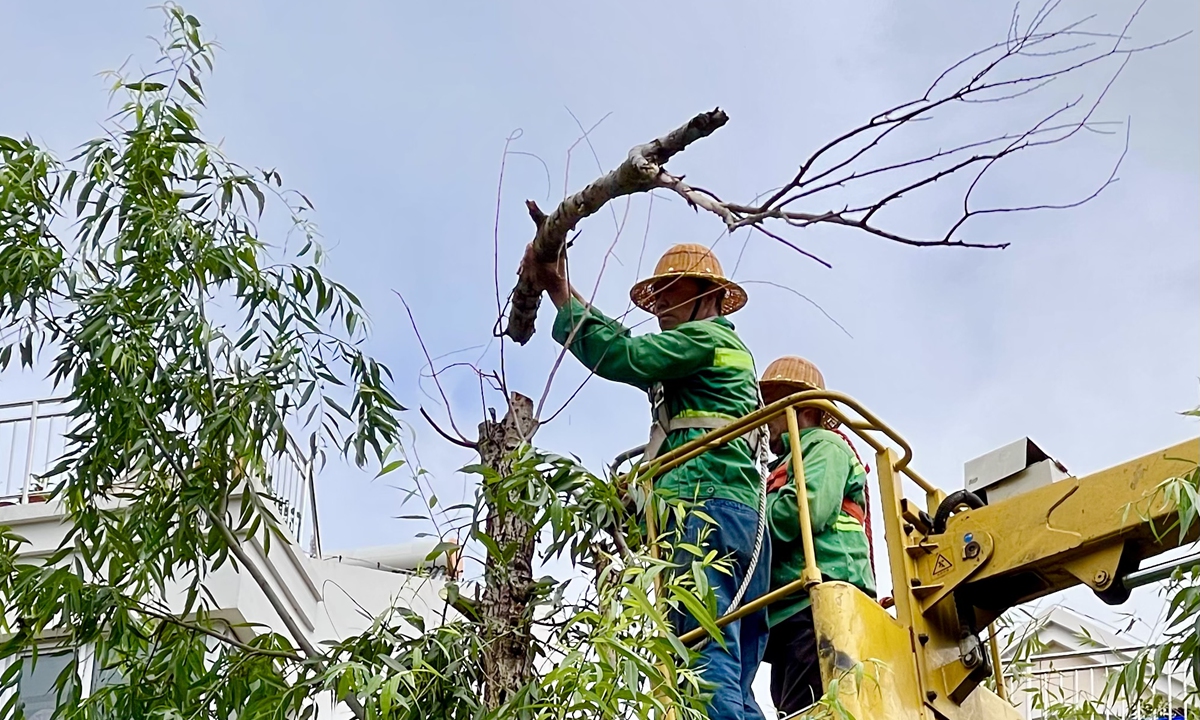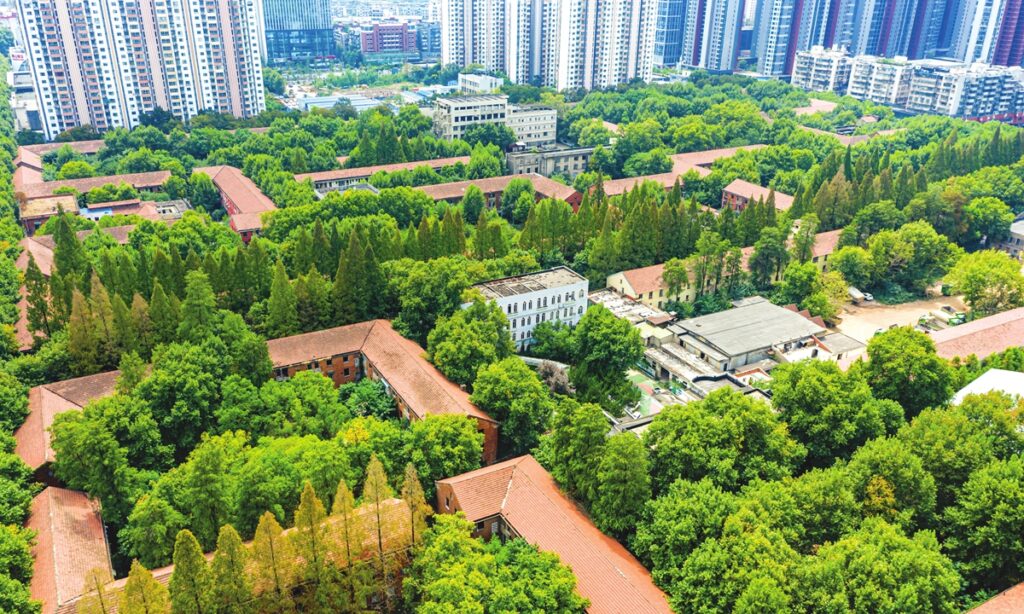Trees cast shadows on the alamedas in a residential community in Shanghai’s Minhang district. Close to Jindu Huahaoyueyuan community’s main gate, are three fragrant camphor trees marked by somewhat special signs, which read: “receding trimming,” “deep trimming,” and “regular trimming,” indicating the trimming degree of each tree.
Tree trimming, a seemingly trivial matter, used to be the community’s long-unsolved problem due to different preferences and demands by local residents. Those who enjoy the shade beneath trees tend to trim the trees less, while those who prefer natural brightness employ heavy-handed trimming, two contradictory opinions often resulting in numerous quarrels in the community over the last decade.
Recently, an in-depth report published by Shanghai-based newspaper Jiefang Daily highlighted the story of “tree trimming,” providing a detailed account of how the community found a solution to a seemingly mundane problem, thanks to the joint efforts of the community residents, managers, as well as related urban planning and greening departments.
The three trees, along with their signs, are hailed as a microcosm of whole-process people’s democracy, as well as a vivid embodiment of the wisdom of grassroots management in Chinese cities. The “tree trimming” story laid out in the Jiefang Daily report has also played out in other residential communities across Shanghai, which experts said demonstrated the country’s great progress in improving whole process people’s democracy and strengthening governance at the grassroots level.
Whole-process people’s democracy, the defining feature of a socialist democracy, is best reflected in people’s participation in democratic elections, consultations, decision-making, management, and oversight in accordance with the law. As a major summary of the theory and practice of Chinese democracy, whole-process people’s democracy is also China’s answer to the chaos of the West and the confusion of Western democracy.
From attraction to ‘obstacles’
One day after dinner, some Jindu Huahaoyueyuan community residents gathered in the community’s park for a chat. An elderly man in the crowd seemed somewhat displeased, saying, “They stopped trimming the trees. I wonder what the issue is this time?”
Trimming trees, more than a decade ago, was a source of anger in the community, according to the article published by Jiefang Daily.
Back then, the lush trees in the neighborhood provided shade, a significant attraction for newcomers to settle in this area. However, after more than a decade since the community was established, the camphor trees grew so tall that they blocked the sunlight for residents in lower-level apartments. An overwhelmingly successful greening project therefore became an “obstacle” for some residents.
“We can hardly see sunlight all year round, and it’s so dark inside,” said one resident, a sentiment echoed by almost all those who suggested tree trimming.
In 2018, a “conflict” erupted in the community over tree trimming. At that time, the Shanghai government issued a three-year action plan for building beautiful homes in Shanghai residential communities. Jindu Huahaoyueyuan community then received project funding, and the community owners’ committee took this opportunity to propose tree trimming.
But after trimming fewer than 10 trees, the project was halted and later abandoned due to residents’ complaints. Some people said the primary reason was “haphazard trimming.”
“For some trees, they directly cut off lower branches, which certainly deviated from the standards for trimming,” assessed Wang Lanhua who participated in the tree trimming project.
Consequently, when the tree trimming project was paused during the summer due to high temperatures this year, residents became especially incensed. Wang explained that in early 2022, Shanghai issued a notice which stipulated that the trimming of residential area trees should take place before spring budding or after autumn tree growth stops to avoid extreme cold and hot weather.
“The workers sweat a lot up there and can get dehydrated. Besides, the trees can’t endure it; they lose moisture too quickly,” he explained to the residents.
Zhang Chao, a member of the community owners’ committee, pointed out that “the issue of tree trimming in this community is particularly sensitive, and a small problem can trigger larger issues.”
Previously, most residents’ attitude has been an eagerness for tree trimming coupled with a distrust of the community owners’ committee.
Liu Junli, who lived in the community for a long time, is now the director of the owners’ committee. She said that the previous owners’ committee had a poor reputation among residents. “So whenever they undertook a project, people would say they were just trying to make money.”
Zhu Fang, a member of the committee, standing nearby, chuckled, indicating that she had grown used to hearing such comments.
Back on agenda
In 2020, the election of the new owners’ committee began and it took over a year to successfully form the new committee.
Restoring trust between the residents and the committee was just the first step. Liu decided to start small, initially addressing issues like unruly parking at the entrance and problems with garbage disposal in the community, “To at least make residents feel that the community committee is taking action,” she told Jiefang Daily.
After successfully handling those issues, the members of the committee felt that this was the time to reintroduce tree trimming into the agenda. With a large number of trees in the community and a substantial amount of money involved, a public bidding process was necessary. Drafting a proposal was the first step. At the time, the committee requested that the bidding companies provide detailed plans before the owners’ meeting, enabling residents to vote on the refined proposals.
Communicating with the residents was done through real-time updates on the community’s WeChat account, and the tree-trimming plan was a crucial topic during offline resident reception days.
During these reception days, there were occasions when residents voiced their opposition to tree trimming. Then the committee arranged for residents who supported and opposed the tree trimming to exchange views face-to-face in the meeting room, dispelling residents’ preconceptions about the committee profiting from these decisions. Often, residents who were initially opposed to tree trimming would be convinced after hearing comprehensive reasons in favor of the trimming from others.
To prevent a repeat of what happened in 2018, Zhang sought help from friends working in related fields and invited experts to conduct an on-site inspection to determine “which trees need trimming and how they should be trimmed.”
Based on the experts’ advice, three demonstration trees appeared at the entrance of the committee. These three trees, pruned to varying degrees, were accompanied with printed explanations on receding trimming, deep trimming, and regular trimming.
Open-eared
During two resident reception days, the registration form of the owners’ committee spanned 14 pages, filled with detailed notes.
After summarizing, it was discovered that residents’ tree-trimming needs primarily fell into two categories. Trimming was requested due to lack of sunlight, branches extending to balconies, or potential window breakages. However, some residents wished for shade on the main road and requested there be no trimming.
“If a tree is situated both on the main road and extends to residents’ balconies, we trim the balcony-facing branches and try to preserve the road-facing branches as much as possible,” Zhang said.

Photos: VCG
On April 2, 2023, the vote result from the owners’ meeting agenda was announced: 1,273 votes were in favor of the proposal, accounting for 67.68 percent, while 150 votes were opposed, at 7.97 percent, making it one of the most highly approved proposals during the owners’ meeting.
Gradually, community cooperation around tree-trimming increased. Zhang sought the advice of experts and found a site-specific solution – deep pruning, which is essentially still a form of receding trimming, but it involves leaving more branches compared to receding trimming. This method strikes a balance between meeting regulatory requirements and addressing residents’ demands.
Wang, with years of tree-trimming experience, noted that in recent years, newly constructed communities began to avoid the problems encountered in older communities during their landscaping planning. Meanwhile, government recommendations are becoming increasingly standardized, with clearer numerical regulations in landscaping ordinances.
Template practice
Similar tree trimming stories have also been seen in other residential communities across Shanghai, Global Times reporters found.
In the city’s downtown Hongkou district, there is a residential community named Tianshui, where many residents are senior citizens. For the elderly, reasonable tree trimming is not only about sunlight and visibility, but also about personal safety.
It’s not easy to satisfy every resident. Usually, those who live on higher floors don’t want the trees trimmed nearly as much as those living on lower floors do, according to local community managers.
Cui Fenglin, the then community Party branch secretary, decided to address the main security concerns first. He invited landscapers to prune the tree branches near the community’s anti-theft electric fence, so as to eliminate the security risks.
“Then, we went doors to doors, collecting various suggestions from people living on different floors,” Cui told the Global Times. Thanks to Cui and his coworkers’ effort, “the vast majority of the residents no longer had a problem with that [tree trimming].”
The tree trimming issue is a very typical example that reflects the whole-process people’s democracy, which is the broadest, truest, and most effective form of democracy, commented public policy expert Peng Xizhe, the executive vice dean of the Shanghai-based Fudan Development Institute.
“Some people may think of significant national affairs when they think of democracy. Actually, democracy has been reflected in all aspects of people’s daily lives,” Peng told the Global Times. “Like the tree trimming, it is a community affair that eventually reaches a consensus, after going through a democratic process that allows everyone to express their views. During the process, people’s democratic awareness is naturally built and increased.”
Also, various forms of grass-roots governance, such as owners’ and neighborhood committees, have blossomed in recent years along with China’s development. They have provided a practical way for the general public to participate in social governance at the grassroots level, Peng noted.
Echoing Peng, Shanghai-based lawyer Wu Xinhui said that the neighborhood committee is a self-governing organization by the residents, and the owners’ committee is the self-governing organization of the property owners. The tree trimming issue illustrates how these two grassroots self-governing organizations in China practice whole-process people’s democracy.
Wu also serves as an expert and a “legislative coordinator” at a national grassroots-level legislation contact stations in Shanghai’s Hongqiao subdistrict. The subdistrict is a township-level administrative division in China’s urban areas.
As one of China’s first set of four national grassroots-level legislation contact stations in use by the Legislative Affairs Commission of the Standing Committee of the National People’s Congress (NPC), the Hongqiao neighborhood, as of early September, had solicited opinions from residents on 84 draft laws over the last eight years.
Including Wu, the several hundred “legislative coordinators” who voluntarily collect and sort through these grassroots opinions, the station in Hongqiao has submitted more than 2,600 suggestions on the country’s various draft laws to the NPC, 180 of which have been adopted.
“We serve as a bridge that directly links China’s top legislature to the general public,” Wu told the Global Times.
(Global Times)




